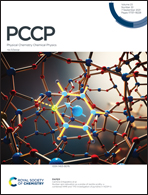1-Alkyl-3-methylimidazolium cation binding preferences in hexafluorophosphate ionic liquid clusters determined using competitive TCID measurements and theoretical calculations†
Abstract
Ionic liquids (ILs) exhibit unique properties that have led to their development and widespread use for a variety of applications. Development efforts have generally focused on achieving desired macroscopic properties via tuning of the IL through variation of the cations and anions. Both the macroscopic and microscopic properties of an IL influence its tunability and thus feasibility of use for selected applications. Works geared toward a microscopic understanding of the nature and strength of the intrinsic cation–anion interactions of ILs have been limited to date. Specifically, the intrinsic strength of the cation–anion interactions in ILs is largely unknown. In previous work, we employed threshold collision-induced dissociation (TCID) approaches supported and enhanced by electronic structure calculations to determine the bond dissociation energies (BDEs) and characterize the nature of the cation–anion interactions in a series of four 2 : 1 clusters of 1-alkyl-3-methylimidazolium cations with the hexafluorophosphate anion, [2Cnmim:PF6]+. To examine the effects of the 1-alkyl chain on the structure and energetics of binding, the cation was varied over the series: 1-ethyl-3-methylimidazolium, [C2mim]+, 1-butyl-3-methylimidazolium, [C4mim]+, 1-hexyl-3-methylimidazolium, [C6mim]+, and 1-octyl-3-methylimidazolium, [C8mim]+. The variation in the strength of binding among these [2Cnmim:PF6]+ clusters was found to be similar in magnitude to the average experimental uncertainty in the measurements. To definitively establish an absolute order of binding among these [2Cnmim:PF6]+ clusters, we extend this work again using TCID and electronic structure theory approaches to include competitive binding studies of three mixed 2 : 1 clusters of 1-alkyl-3-methylimidazolium cations and the hexafluorophosphate anion, [Cn−2mim:PF6:Cnmim]+ for n = 4, 6, and 8. The absolute BDEs of these mixed [Cn−2mim:PF6:Cnmim]+ clusters as well as the absolute difference in the strength of the intrinsic binding interactions as a function of the cation are determined with significantly improved precision. By combining the thermochemical results of the previous independent and present competitive measurements, the BDEs of the [2Cnmim:PF6]+ clusters are both more accurately and more precisely determined. Comparisons are made to results for the analogous [2Cnmim:BF4]+ and [Cn−2mim:BF4:Cnmim]+ clusters previously examined to elucidate the effects of the [PF6]− and [BF4]− anions on the binding.



 Please wait while we load your content...
Please wait while we load your content...